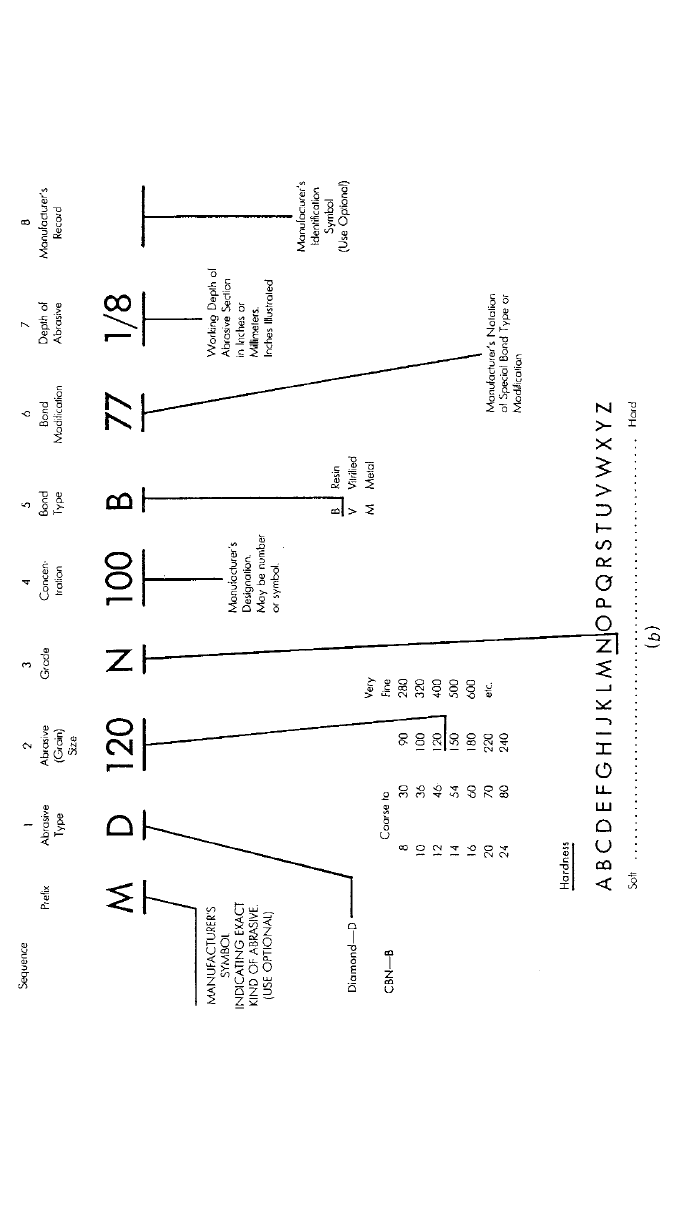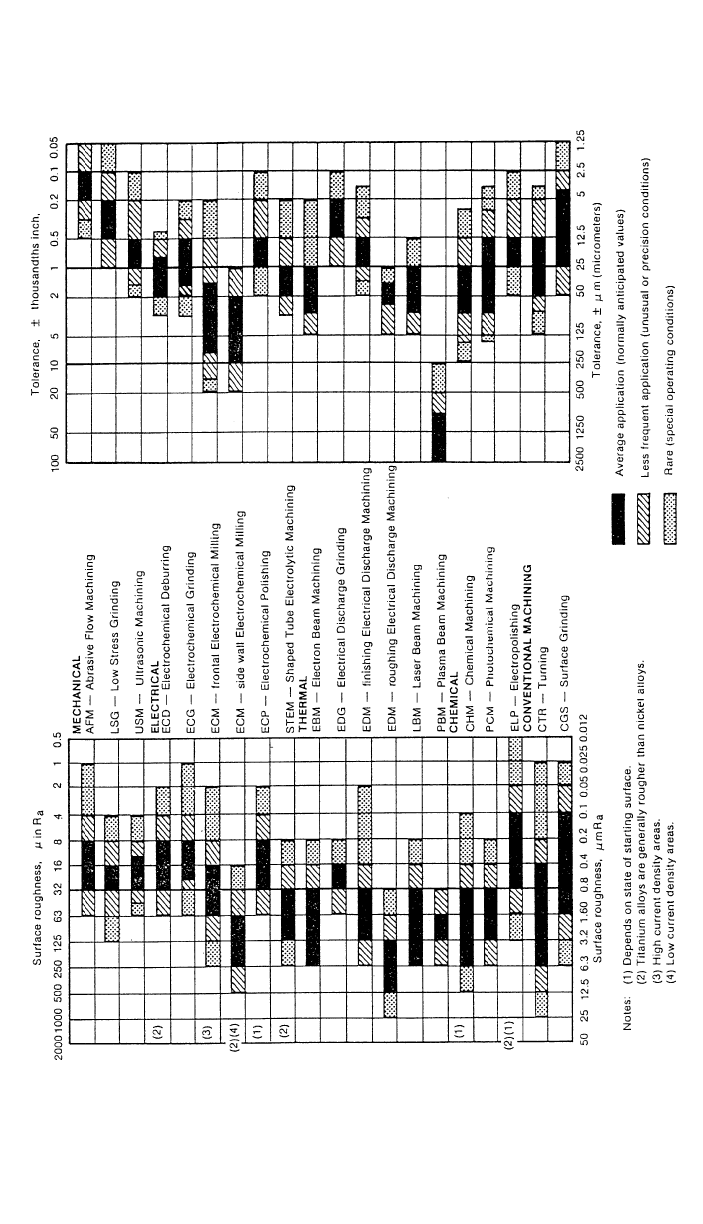Kutz M. Handbook of materials selection
Подождите немного. Документ загружается.


14 MACHINING PLASTICS 893
pulls and ejects the softened metal. About 0.5 min are required to cut through
a 24-in. I-beam.
Abrasive disks are mainly aluminum oxide grains or silicon carbide grains
bonded together. They will cut ferrous or nonferrous metals. The finish and
accuracy is better than steel friction blades, but they are limited in size compared
to steel friction blades.
Band saw blades are of the continuous type. Band sawing can be used for
cutting and contouring. Band-sawing machines operate with speeds that range
from 50–1500 fpm. The time required to cut a workpiece of width W in. can
be calculated as follows:
W
T ⫽ min (70)
12ƒ nV
t
where ƒ
t
⫽ feed, in. per tooth
n
⫽ number of teeth per in.
V
⫽ cutting speed, fpm
Cutting can also be achieved by band-friction cutting blades with a surface speed
up to 15,000 fpm. Other band tools include band filing, diamond bands, abrasive
bands, spiral bands, and special-purpose bands.
14 MACHINING PLASTICS
Most plastics are readily formed, but some machining may be required. Plastic’s
properties vary widely. The general characteristics that affect their machinability
are discussed below.
First, all plastics are poor heat conductors. Consequently, little of the heat
that results from chip formation will be conducted away through the material or
carried away in the chips. As a result, cutting tools run very hot and may fail
more rapidly than when cutting metal. Carbide tools frequently are more eco-
nomical to use than HSS tools if cuts are of moderately long duration or if high-
speed cutting is to be done.
Second, because considerable heat and high temperatures do develop at the
point of cutting, thermoplastics tend to soften, swell, and bind or clog the cutting
tool. Thermosetting plastics give less trouble in this regard.
Third, cutting tools should be kept very sharp at all times. Drilling is best
done by means of straight-flute drills or by ‘‘dubbing’’ the cutting edge of a
regular twist drill to produce a zero rake angle. Rotary files and burrs, saws, and
milling cutters should be run at high speeds in order to improve cooling, but
with feed carefully adjusted to avoid jamming the gullets. In some cases, cool-
ants can be used advantageously if they do not discolor the plastic or cause
gumming. Water, soluble oil and water, and weak solutions of sodium silicate
in water are used. In turning and milling plastics, diamond tools provide the best
accuracy, surface finish, and uniformity of finish. Surface speeds of 500–600
fpm with feeds of 0.002–0.005 in. are typical.
Fourth, filled and laminated plastics usually are quite abrasive and may pro-
duce a fine dust that may be a health hazard.

894 PRODUCTION PROCESSES AND EQUIPMENT FOR METALS
15 GRINDING, ABRASIVE MACHINING, AND FINISHING
Abrasive machining is the basic process in which chips are removed by very
small edges of abrasive particles, usually synthetic. In many cases, the abrasive
particles are bonded into wheels of different shapes and sizes. When wheels are
used mainly to produce accurate dimensions and smooth surfaces, the process
is called grinding. When the primary objective is rapid metal removal to obtain
a desired shape or approximate dimensions, it is termed abrasive machining.
When fine abrasive particles are used to produce very smooth surfaces and to
improve the metallurgical structure of the surface, the process is called finishing.
15.1 Abrasives
Aluminum oxide (Al
2
O
3
), usually synthetic, performs best on carbon and alloy
steels, annealed malleable iron, hard bronze, and similar metals. Al
2
O
3
wheels
are not used in grinding very hard materials, such as tungsten carbide, because
the grains will get dull prior to fracture. Common trade names for aluminum
oxide abrasives are Alundum and Aloxite.
Silicon carbide (SiC), usually synthetic, crystals are very hard, being about
9.5 on the Moh’s scale, where diamond hardness is 10. SiC crystals are brittle,
which limits their use. Silicon carbide wheels are recommended for materials of
low tensile strength, such as cast iron, brass, stone, rubber, leather, and cemented
carbides.
Cubic boron nitride (CBN) is the second-hardest natural or manmade sub-
stance. It is good for grinding hard and tough-hardened tool-and-die steels.
Diamonds may be classified as natural or synthetic. Commercial diamonds
are now manufactured in high, medium, and low impact strength.
Grain Size
To have uniform cutting action, abrasive grains are graded into various sizes,
indicated by the numbers 4–600. The number indicates the number of openings
per linear inch in a standard screen through which most of the particles of a
particular size would pass. Grain sizes from 4–24 are termed coarse; 30–60,
medium; and 70–600, fine. Fine grains produce smoother surfaces than coarse
ones but cannot remove as much metal.
Bonding materials have the following effects on the grinding process: (1)
they determine the strength of the wheel and its maximum speed; (2) they de-
termine whether the wheel is rigid or flexible; and (3) they determine the force
available to pry the particles loose. If only a small force is needed to release the
grains, the wheel is said to be soft. Hard wheels are recommended for soft
materials and soft wheels for hard materials. The bonding materials used are
vitrified, silicate, rubber, resinoid, shellac, and oxychloride.
Structure or Grain Spacing
Structure relates to the spacing of the abrasive grain. Soft, ductile materials
require a wide spacing to accommodate the relatively large chips. A fine finish
requires a wheel with a close spacing. Figure 29 shows the standard system of
grinding wheels as adopted by the American National Standards Institute.

15 GRINDING, ABRASIVE MACHINING, AND FINISHING 895
Speeds
Wheel speed depends on the wheel type, bonding material, and operating con-
ditions. Wheel speeds range between 4500 and 18,000 sfpm (22.86 and 27.9 m/
s). 5500 sfpm (27.9 m/s) is generally recommended as best for all disk-grinding
operations. Work speeds depend on type of material, grinding operation, and
machine rigidity. Work speeds range between 15 and 200 fpm.
Feeds
Cross feed depends on the width of grinding wheel. For rough grinding, the
range is one-half to three-quarters of the width of the wheel. Finer feed is re-
quired for finishing, and it ranges between one-tenth and one-third of the width
of the wheel. A cross feed between 0.125 and 0.250 in. is generally recom-
mended.
Depth of Cut
Rough-grinding conditions will dictate the maximum depth of cut. In the finish-
ing operation, the depth of cut is usually small, 0.0002–0.001 in. (0.005–0.025
mm). Good surface finish and close tolerance can be achieved by ‘‘sparking out’’
or letting the wheel run over the workpiece without increasing the depth of cut
till sparks die out. The grinding ratio (G-ratio) refers to the ratio of the cubic
inches of stock removed to the cubic inches of grinding wheel worn away. G-
ratio is important in calculating grinding and abrasive machining cost, which
may be calculated by the following formula:
C
L
a
C ⫽⫹ (71)
Gtq
where C
⫽ specific cost of removing a cu in. of material
C
a
⫽ cost of abrasive, $/in.
3
G ⫽ grinding ratio
L
⫽ labor and overhead charge, $/hr
q
⫽ machining rate, in.
3
/hr
t
⫽ fraction of time the wheel is in contact with workpiece
Power Requirement
Power ⫽ (u)(MRR) ⫽ F ⫻ R ⫻ 2
N
c
MRR ⫽ material removal rate ⫽ d ⫻ w ⫻ v
where d ⫽ depth of cut
w
⫽ width of cut
v ⫽ work speed
u
⫽ specific energy for surface grinding. Table 14 gives the approximate
specific energy requirement for certain metals.
R
⫽ radius of wheel
N
⫽ rev/unit time

896

897
Fig. 29 Standard systems for grinding wheels. (a) aluminum oxide, silicon carbide; (b) diamond, CBN.

898 PRODUCTION PROCESSES AND EQUIPMENT FOR METALS
Table 14 Approximate Specific Energy Required for Surface Grinding
Workpiece Material Hardness hp (in.
3
/min) W / (mm
3
/sec)
Aluminum 150 HB 3–10 8–27
Steel (110–220) HB 6–24 16–66
Cast iron (140–250) HB 5–22 14–60
Titanium alloy 300 HB 6–20 16–55
Tool steel 62–67 HRC 7–30 19–82
15.2 Temperature
Temperature rise affects the surface properties and causes residual stresses on
the workpiece. It is related to process variables by the following relation:
1/2
V
1/4 3/4
temperature rise ⬀ Dd (72)
冉冊
v
where D ⫽ wheel diameter
V
⫽ wheel speed
Grinding Fluids
Grinding fluids are water-base emulsions for general guiding and oils for thread
and gear grinding. Advantages include:
1. Machining hard materials
⬎ RC50.
2. Fine surface finish, 10–80
in. (0.25–2
m).
3. Accurate dimensions and close tolerances I.0002 in. (I.005 mm) can be
easily achieved.
4. Grinding pressure is light.
Machines
Grinding and abrasive machines include
1. Surface grinders, reciprocating or rotating table
2. Cylindrical grinders, work between centers, centerless, crankshaft, thread
and gear form work, and internal and other special applications
3. Jig grinders
4. Tool and cutter grinders
5. Snagging, foundry rough work
6. Cutting off and profiling
7. Abrasive grinding, belt, disk and loose grit
8. Mass media, barrel tumbling, and vibratory
Ultrasonic Machining
In ultrasonic machining, material is removed from the workpiece by microchip-
ping or erosion through high-velocity bombardment by abrasive particles, in the

16 NONTRADITIONAL MACHINING 899
form of a slurry, through the action of an ultrasonic transducer. It is used for
machining hard and brittle materials and can produce very small and accurate
holes 0.015 in. (0.4 mm).
Surface Finishing
Finishing processes produce an extra-fine surface finish; in addition, tool marks
are removed and very close tolerances are achieved. Some of these processes
follow.
Honing is a low-velocity abrading process. It uses fine abrasive stones to
remove very small amounts of metals usually left from previous grinding pro-
cesses. The amount of metal removed is usually less than 0.005 in. (0.13 mm).
Because of low cutting speeds, heat and pressure are minimized, resulting in
excellent sizing and metallurgical control.
Lapping is an abrasive surface-finishing process wherein fine abrasive parti-
cles are charged in some sort of a vehicle, such as grease, oil, or water, and are
embedded into a soft material, called a lap. Metal laps must be softer than the
work and are usually made of close-grained gray cast iron. Other materials, such
as steel, copper, and wood, are used where cast iron is not suitable. As the
charged lap is rubbed against a surface, small amounts of material are removed
from the harder surface. The amount of material removed is usually less than
0.001 in. (0.03 mm).
Superfinishing is a surface-improving process that removes undesirable frag-
mentation, leaving a base of solid crystalline metal. It uses fine abrasive stones,
like honing, but differs in the type of motion. Very rapid, short strokes, very
light pressure, and low-viscosity lubricant–coolant are used in superfinishing. It
is essentially a finishing process and not a dimensional one, and can be super-
imposed on other finishing operations.
Buffing
Buffing wheels are made from a variety of soft materials. The most widely used
is muslin, but flannel, canvas, sisal, and heavy paper are used for special appli-
cations. Buffing is usually divided into two operations: cutting down and col-
oring. The first is used to smooth the surface and the second to produce a high
luster. The abrasives used are extremely fine powders of aluminum oxide, tripoli
(an amorphous silicon), crushed flint or quartz, silicon carbide, and red rouge
(iron oxide). Buffing speeds range between 6,000 and 12,000 fpm.
Electropolishing is the reverse of electroplating; that is, the work is the anode
instead of the cathode and metal is removed rather than added. The electrolyte
attacks projections on the workpiece surface at a higher rate, thus producing a
smooth surface.
16 NONTRADITIONAL MACHINING
Nontraditional, or nonconventional, machining processes are material-removal
processes that have recently emerged or are new to the user. They have been
grouped for discussion here according to their primary energy mode; that is,
mechanical, electrical, thermal, or chemical, as shown in Table 15.
Nontraditional processes provide manufacturing engineers with additional
choices or alternatives to be applied where conventional processes are not sat-
isfactory, such as when

900
Table 15 Current Commercially Available Nontraditional Material Removal Processes
Mechanical Electrical Thermal Chemical
AFM
AJM
HDM
LSG
RUM
TAM
TFM
USM
WJM
Abrasive flow machining
Abrasive jet machining
Hydrodynamic machining
Low-stress grinding
Rotary ultrasonic
machining
Thermally assisted
machining
Total form machining
Ultrasonic machining
Water-jet machining
ECD
ECDG
ECG
ECH
ECM
ECP
ECS
ECT
ES
STEM
娃
Electrochemical deburring
Electrochemical discharge
grinding
Electrochemical grinding
Electrochemical honing
Electrochemical machining
Electrochemical polishing
Electrochemical sharpening
Electrochemical turning
Electro-stream
娃
Shaped tube electrolytic
machining
EBM
EDG
EDM
EDS
EDWC
LBM
LBT
PBM
Electron-beam machining
Electrical discharge
grinding
Electrical discharge
machining
Electrical discharge sawing
Electrical discharge wire
cutting
Laser-beam machining
Laser-beam torch
Plasma-beam machining
CHM
ELP
PCM
TCM
Chemical machining:
chemical milling,
chemical blanking
Electropolish
Photochemical machining
Thermochemical
machining (or TEM,
thermal energy method)

16 NONTRADITIONAL MACHINING 901
●
Shapes and dimensions are complex or very small
●
Hardness of material is very high (⬎400 HB)
●
Tolerances are tight and very fine surface finish is desired
●
Temperature rise and residual stresses must be avoided
●
Cost and production time must be reduced
Figure 30 and Table 16 demonstrate the relationships among the conventional
and the nontraditional machining processes with respect to surface roughness,
dimensional tolerance, and metal-removal rate.
The Machinery Handbook
6
is an excellent reference for nontraditional ma-
chining processes, values, ranges, and limitations.
16.1 Abrasive Flow Machining
Abrasive flow machining (AFM) is the removal of material by a viscous, abra-
sive medium flowing, under pressure, through or across a workpiece. Figure 31
contains a schematic presentation of the AFM process. Generally, the putty-like
medium is extruded through or over the workpiece with motion usually in both
directions. Aluminum oxide, silicon carbide, boron carbide, or diamond abra-
sives are used. The movement of the abrasive matrix erodes away burrs and
sharp corners and polishes the part.
16.2 Abrasive Jet Machining
Abrasive jet machining (AJM) is the removal of material through the action of
a focused, high-velocity stream of fine grit or powder-loaded gas. The gas should
be dry, clean, and under modest pressure. Figure 32 shows a schematic of the
AJM process. The mixing chamber sometimes uses a vibrator to promote a
uniform flow of grit. The hard nozzle is directed close to the workpiece at a
slight angle.
16.3 Hydrodynamic Machining
Hydrodynamic machining (HDM) removes material by the stroking of high-
velocity fluid against the workpiece. The jet of fluid is propelled at speeds up
to Mach 3. Figure 33 shows a schematic of the HDM operation.
16.4 Low-Stress Grinding
Low-stress grinding (LSG) is an abrasive material-removal process that leaves
a low-magnitude, generally compressive residual stress in the surface of the
workpiece. Figure 34 shows a schematic of the LSG process. The thermal effects
from conventional grinding can produce high tensile stress in the workpiece
surface. The process parameter guidelines can be applied to any of the grinding
modes: surface, cylindrical, centerless, internal, and so on.
16.5 Thermally Assisted Machining
Thermally assisted machining (TAM) is the addition of significant amounts of
heat to the workpiece immediately prior to single-point cutting so that the ma-
terial is softened but the strength of the tool bit is unimpaired (Fig. 35). While
resistive heating and induction heating offer possibilities, the plasma arc has a
core temperature of 14,500
⬚F (8000⬚C) and a surface temperature of 6500⬚F

902
Fig. 30 Typical surface roughness and tolerances produced by nontraditional machining.
